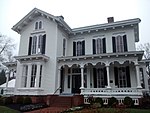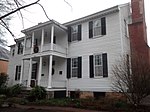Lewis-Smith House
Greek Revival houses in North CarolinaHouses completed in 1856Houses in Raleigh, North CarolinaHouses on the National Register of Historic Places in North CarolinaItalianate architecture in North Carolina ... and 3 more
National Register of Historic Places in Raleigh, North CarolinaRaleigh, North Carolina Registered Historic Place stubsRaleigh, North Carolina building and structure stubs

Lewis-Smith House is a historic home located at Raleigh, Wake County, North Carolina, USA It was built between 1854 and 1856, and is a two-story, three-bay, Greek Revival-style frame dwelling with a low hipped roof and Italianate-style brackets. It features a two-tier pedimented entrance portico, with paired Doric order columns at the first level and well-detailed Ionic order ones at the second. Two-story, demi-octagonal projecting bays were added to the sides in the early-20th century.It was listed on the National Register of Historic Places in 1972.
Excerpt from the Wikipedia article Lewis-Smith House (License: CC BY-SA 3.0, Authors, Images).Lewis-Smith House
North Blount Street, Raleigh Seaboard Station
Geographical coordinates (GPS) Address Nearby Places Show on map
Geographical coordinates (GPS)
| Latitude | Longitude |
|---|---|
| N 35.785555555556 ° | E -78.635555555556 ° |
Address
North Blount Street
27604 Raleigh, Seaboard Station
North Carolina, United States
Open on Google Maps









